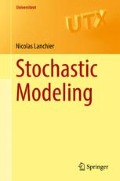Abstract
As in the Wright–Fisher and Moran models, the two configurations in which all the individuals have the same type or share the same opinion are absorbing states for the voter model. However, at least starting with infinitely many individuals of each type, the time to fixation to one of these absorbing states is almost surely infinite, which allows for the possibility of interesting transient or long-term behaviors. In fact, even though it does not depend on any parameter, the voter model exhibits very rich dynamics with various behaviors depending on the spatial dimension. This contrasts with the contact process that has behavior similar in any dimension.
Access this chapter
Tax calculation will be finalised at checkout
Purchases are for personal use only
References
M. Bramson and D. Griffeath. Renormalizing the 3-dimensional voter model. Ann. Probab., 7(3):418–432, 1979.
M. Bramson and D. Griffeath. Clustering and dispersion rates for some interacting particle systems on Z. Ann. Probab., 8(2):183–213, 1980.
J. T. Cox and D. Griffeath. Occupation time limit theorems for the voter model. Ann. Probab., 11(4):876–893, 1983.
J. T. Cox and D. Griffeath. Diffusive clustering in the two-dimensional voter model. Ann. Probab., 14(2):347–370, 1986.
R. A. Holley and T. M. Liggett. Ergodic theorems for weakly interacting infinite systems and the voter model. Ann. Prob., 3(4):643–663, 1975.
N. Lanchier. The Axelrod model for the dissemination of culture revisited. Ann. Appl. Probab., 22(2):860–880, 2012.
I. Zähle. Renormalization of the voter model in equilibrium. Ann. Probab., 29(3):1262–1302, 2001.
Author information
Authors and Affiliations
Rights and permissions
Copyright information
© 2017 Springer International Publishing AG
About this chapter
Cite this chapter
Lanchier, N. (2017). The voter model. In: Stochastic Modeling. Universitext. Springer, Cham. https://doi.org/10.1007/978-3-319-50038-6_16
Download citation
DOI: https://doi.org/10.1007/978-3-319-50038-6_16
Published:
Publisher Name: Springer, Cham
Print ISBN: 978-3-319-50037-9
Online ISBN: 978-3-319-50038-6
eBook Packages: Mathematics and StatisticsMathematics and Statistics (R0)

